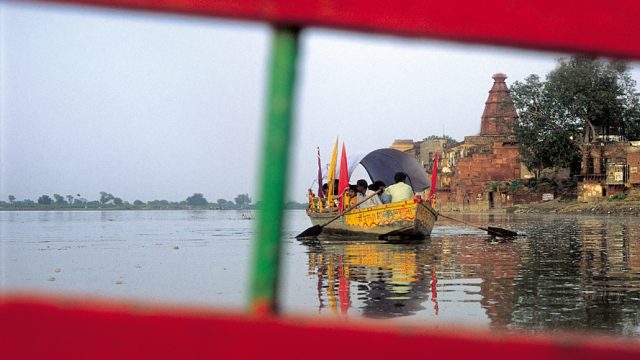Braj is the land of the young Krishna. Not the warrior-statesman of the Mahabharata, not the philosopher-god of the Gita, not the king of Mathura and Dwarka. The land about which an adult but distraught Krishna said to his friend Uddhav, “Udho, mohe Braj bisarat nahi” (Udho, I cannot forget Braj). Here he had enacted the playful, love-soaked chapter of his boyhood, here he was a cowherd and famously stole butter, teased gopis, played the flute, and danced on moonlit nights with the lovely Radha.
The whole land is defined by Krishna’s mythology. Mathura, where Krishna was born; Gokul, across the Yamuna from Mathura, where he was taken for safekeeping with foster-parents Nanda and Yashoda; Vrindavan, where he spent his most ras-drenched years, loving and being loved by Radha and the gopis, playing the inexorably magnetic tunes of his flute; Govardhan, the hill he lifted on his finger for seven days to save the people of Braj from Indra’s wrath; Barsana, the village of Radha; and close to it, Nandagaon, Nanda’s village.
For centuries, Braj and Vrindavan existed only as concepts in texts such as Bhagwat Purana, Jaidev’s Geet Govinda, or Raskhanand Surdas’ verses. But as we know it today, the area of Braj was realised by several 15th and 16th century Bhakti saints, the most well-known of whom was Chaitanya Mahaprabhu (born 1486). He became a devotee of Krishna and came to Braj on a pilgrimage to see the sites associated with his beloved Krishna in the year 1515.
But none of these places, except Mathura, was evident. For months he sought and, in a series of divine visions and realisations, identified Vrindavan along with other key sites. Saints such as Chaitanya, Hit Harivamsa, Swami Haridas, Vallabhacharya and their followers ‘settled’ Braj in the 16th century, with ghats built on the Yamuna, miraculous discoveries of idols, temples made in Vrindavan region, and literary records. They themselves became objects of devotion for their followers (Chaitanya is understood to be a reincarnation of Krishna and Radha together) and the sects set up in their name, such as Gaudiya for the Chaitanya-inspired ecstatic devotional movement, or Pushtimarg founded by Vallabhacharya, flourish in Vrindavan even today, as does the love for Krishna and Radha.




